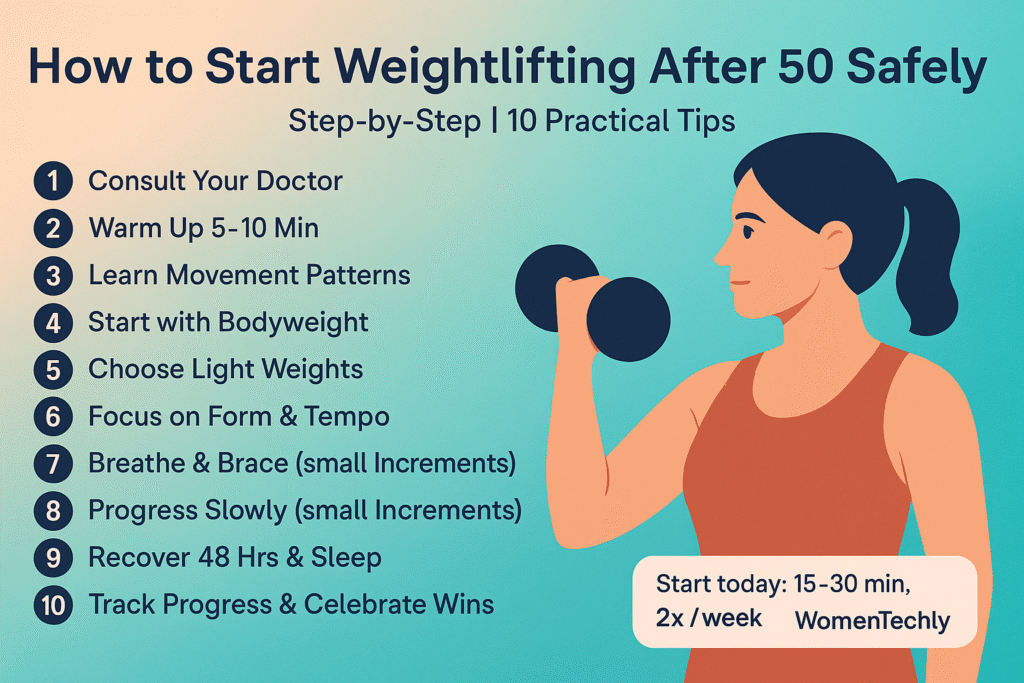If you are a woman over 50 the idea of stepping into a gym filled with dumbbells and barbells might feel intimidating maybe you have thought That’s for younger women, or I don’t want to hurt myself you are not alone many women hesitate to embrace weightlifting later in life because of fear, myths, or simply not knowing where to start.
But here is the truth weightlifting for women over 50 can be life changing it is not about bulging muscles or competing with anyone else It’s about reclaiming your health, strengthening your body and proving to yourself that age is not a barrier to power.
Whether you want to stay active for grandkids, protect your bones, keep your independence or simply feel more confident in your own skin strength training can help you get there and yes you can do it safely no matter where you are starting from.
Table of Contents
Why Weightlifting For Women Over 50 Matters ?
By the time we reach 50 our bodies naturally begin to lose muscle mass and bone density without strength training this can lead to weakness, fatigue and even falls but lifting weights helps reverse these changes.
Key benefits of weightlifting for women over 50 include:
- Stronger Bones: Resistance training stimulates bone growth, lowering the risk of osteoporosis.
- Improved Posture: Strengthening your back and core helps you stand tall and move with confidence.
- Boosted Metabolism: Muscle burns more calories than fat helping with weight management even at rest.
- Independence: From carrying groceries to climbing stairs strength makes everyday life easier.
- Confidence and Empowerment: Feeling your body grow stronger is deeply motivating and liberating.
Think of weightlifting as an investment not just in your health but in your freedom, joy, and vitality.
Myths About Weightlifting for Women Over 50
Stepping into strength training at 50 or beyond often means carrying not just dumbbells but also doubts and misconceptions.
Let’s set the record straight
Myths About Weightlifting over 50
Health Benefits of Strength Training For Women Over 50
Strength training is not just about looking toned its about protecting your health reclaiming your energy and staying independent for decades to come for women over 50 it can feel like discovering a hidden secret with just a few weights and consistent effort you can turn back the clock on many age related challenges.
Stronger Bones, Lower Risk of Osteoporosis
After menopause bone density naturally declines, leaving women more vulnerable to fractures weightlifting stimulates bone growth making bones stronger and less fragile think of it as Armor for your skeleton.
Relief for Achy Joints and Arthritis
It may sound surprising but lifting weights does not damage joints it supports them when the muscles around your knees, hips and shoulders get stronger they take pressure off the joints many women report less stiffness better range of motion, and easier movement in daily life.
A Healthy, Happy Heart
Strength training improves circulation, lowers blood pressure and helps regulate cholesterol combined with a healthy diet it is a powerful ally against heart disease one of the biggest health concerns for women after 50.
Boosted Metabolism and Easier Weight Management
Muscle tissue burns more calories than fat even while you rest that means strength training helps keep your metabolism active making it easier to maintain or lose weight without extreme diets.
Improved Balance and Mobility
Strong legs, hips and core muscles mean better stability this reduces the risk of falls a major concern as we age and gives you the confidence to move freely whether its dancing, gardening, or hiking.
Longevity and Quality of Life
Studies show women who strength train regularly live longer healthier lives more importantly they live better staying active independent and joyful well into their later years.
How to Start Weightlifting After 50 Safely: Step-by-Step, Practical and Proven
I know starting something new at 50+ can feel scary let’s make it simple, safe and deeply practical below is a step by step playbook you can follow today no guesswork, no intimidation just clear actions that build real strength and confidence.

Step 1 Get a Quick Health Check and Set Tiny Goals
Before you lift a single weight do these two things:
- Talk to your doctor: if you have heart disease uncontrolled blood pressure, recent surgery, severe osteoporosis or any ongoing medical questions most women are cleared quickly and even with conditions there are safe ways to train.
- Write one small meaningful goal. Example I want to stand up from the couch without using my hands or I want to walk up two flights of stairs without getting winded. small goals keep you motivated.
This is how to start weightlifting at 50 in a way that respects your body and your life.
Step 2 Warm Up Like It Matters (because it does) 5–10 Minutes
A good warm-up prevents injury and makes your session more effective try this quick routine:
- 2–3 minutes brisk walking, marching in place, or gentle cycling.
- 6–8 dynamic mobility moves (30–45 seconds each) arm circles, hip circles, leg swings (front-to-back) ankle circles, shoulder rolls, and glute bridges.
- Finish with 1 set of a movement pattern you’ll train (e.g., 8 bodyweight squats).
Warming up raises your core temperature, lubricates joints and primes the nervous system you will lift safer and feel better.
Step 3 Learn The Five Essential Movement Patterns First
Before you add heavy weights, master these patterns using bodyweight or light bands:
- Hinge (deadlift pattern) hip drive, neutral spine.
- Squat sit-to-stand control.
- Push chest/shoulder pressing motion.
- Pull rowing for back strength and posture.
- Carry/Core farmer carries or standing core work.
Practice 1–2 sets of each, 8–12 reps these patterns are the foundation of every safe program and the secret to functional strength.
Step 4 Choose The Right Equipment and Starting Weights
You don’t need a full gym start with:
- A pair of dumbbells (adjustable or multiple pairs) a kettlebell, or resistance bands.
- A stable chair or a low box for sit-to-stand and step ups.
- Good supportive shoes and the best sports bras for large breasts for comfort and confidence.
How To Pick a Starting Weight
- Choose a weight that lets you complete 8–12 reps with good form and leaves the last 2 reps challenging but doable (that’s roughly RPE 6–7 on a 1–10 effort scale).
- If unsure begin lighter many women start upper body work at 2–5 lbs and lower body at 5–15 lbs then adjust the goal is controlled confident movement over ego.
Step 5 Proper Breathing and Tempo (so you lift safely)
- Breathe out on the effort (for example exhale while pushing or lifting) and inhale on the return.
- Use a controlled tempo 2 seconds down, 1 second pause, 2 seconds up (2-1-2). Slower reps build strength and reinforce good technique.
Avoid breath holding especially when you are just beginning it spikes blood pressure and makes you dizzy.
Step 6 A Simple Beginner Routine You Can Start Today (2–3x per week)
Begin with full-body sessions twice a week (e.g., Monday + Thursday). Each session takes 25–40 minutes including warm-up.
Session A Full body (example)
Progression Plan (Practical):
This is a safe weightlifting routine for women over 50 that builds strength steadily.
Step 7 How and When to Increase Weight (progression rules)
Progress gradually that’s how gains are permanent and safe.
- Rule of thumb: If you can complete the top of your rep range with perfect form and feel you could do 2–3 more, increase weight next session.
- Small jumps: Add 1–2 lbs for upper-body moves and 2.5–5 lbs for lower-body moves machines and plates often increase in larger steps add extra reps or slow the tempo instead.
- Alternate options to make it harder: more reps, slower eccentric (lowering) phase or shorter rest.
Patience + small consistent increases = long-term strength.
Step 8 Recovery, Nutrition, and Tracking (don’t skip this)
- Rest days matter: Aim for 48 hours between intense lifting sessions for the same muscle groups.
- Protein: Aim for a protein source at each meal eggs, dairy, fish, beans especially after workouts.
- Sleep and hydration are non negotiable for recovery.
- Track progress with a simple training log or with tools like fitness trackers and wellness apps to monitor workouts, steps, and heart-rate recovery seeing progress is highly motivating.
If you enjoy gentle movement on rest days consider online yoga classes to improve mobility and breath.
Step 9 Safety Red Flags & When to Stop or See Help
Stop and seek immediate help if you experience:
- Chest pain, sudden shortness of breath, fainting, or severe dizziness.
- Sharp joint pain or a new swelling after a lift.
- New neurological symptoms like numbness or weakness.
If you have chronic joint pain or past injuries consult a physical therapist for a tailored plan a few sessions with a trainer who works with older adults can be an excellent investment in safe technique.
Step 10 Build Confidence and Create a Habit You’ll Keep
- Start with short, consistent sessions: 20–30 minutes 2–3 times per week.
- Celebrate small wins: more reps, better posture, easier stairs.
- Use a buddy or join a supportive class if you want to hike stronger later this work makes carrying gear and climbs feel joyful with best women hiking accessories once you feel ready.
- When you struggle with focus a digital detox day and a short walk can reset your energy and motivation.
Starting weightlifting for women over 50 does not have to be complicated or risky it is a sequence of small intentional steps check in with your health, warm up, learn movement patterns pick sensible weights, progress slowly and prioritize recovery.
Do this consistently and you’ll build strength that supports everything you love to do.
Tips for Building Confidence in the Gym for Women Over 50
Confidence is a skill you can build and small, repeatable habits create big, lasting change below are the most effective proven ways to feel calm, competent, and proud in the weight room in the gym.
- Bring a 3-move plan: Know exactly three exercises and their order arriving prepared reduces decision fatigue, saves time and keeps you focused so short gym visits become efficient strength sessions that build consistency and real confidence.
- Book one trainer session: Invest in a single session to learn safe cues personalized modifications, and a short routine you enjoy hands on guidance corrects form quickly, removes doubt, and accelerates progress so you can train independently.
- Start 15–20 minutes: Begin with a short bodyweight or band circuit to create momentum brief sessions remove pressure, fit busy schedules, and prove strength work is doable helping you show up more often and feel capable faster.
- Go off-peak: Choose quieter hours or women/senior sessions so you can learn equipment and move at your own pace without crowds low traffic times reduce anxiety let you ask staff questions and improve focus on form.
- Wear a supportive bra & stable shoes: Comfortable well-fitted gear prevents distraction, reduces bounce and discomfort and improves posture when clothing feels secure you’ll move better, focus more, and stay committed to each workout.
- Log one metric: Track weight, reps or session length in a notebook or app seeing measurable progress each week builds momentum, removes doubt about effectiveness and motivates you to continue because the gains become undeniable.
- Bring a buddy or join a class: shared workouts add accountability, social support and encouragement pairing with another woman or attending a small class increases consistency makes training enjoyable, and diminishes gym intimidation.
- Have quick substitutions: Memorize backups like step ups, band rows or floor presses for busy equipment days flexible alternatives keep your workout effective, prevent excuses and ensure you always complete a meaningful strength session.
Best Nutrition and Recovery Tips For Women Over 50
Good nutrition is the backbone of progress aim for 20–30 grams of protein at each meal (or roughly 1.0–1.2 g/kg body weight if you want a guideline) older muscles need more amino acids to rebuild. Prioritize complete proteins: eggs, Greek yogurt, cottage cheese, fish, poultry, beans, and a scoop of whey or pea protein after harder sessions.
You can use nutrition apps for taking best nutrition fill half your plate with colourful vegetables and fruits (berries, leafy greens, cruciferous veg) which provide antioxidants and reduce inflammation add healthy fats olive oil, avocado and a small handful of nuts also include fatty fish twice a week for omega-3s which help joint comfort and recovery.
Best Nutrition and Recovery Tips
Common Mistakes to Avoid In Weightlifting For Women Over 50
- Skipping the warm-up: Cold muscles and stiff joints increase injury risk spend 5–10 minutes on dynamic mobility and a light cardio warm-up before every session.
- Lifting too heavy too soon: Progress with small weight increments and nail form first if the last 2 reps aren’t challenging but clean consider a tiny weight increase next session.
- Relying only on machines or isolation moves: Machines have their place but prioritize functional, compound patterns (squat, hinge, push, pull, carry) for real life strength and balance.
- Holding your breath during heavy lifts: Breath holding spikes blood pressure exhale on the effort, inhale on the return and use a controlled tempo to protect your heart and core.
- Ignoring joint pain vs. normal soreness: Mild muscle soreness is normal sharp or persistent joint pain is a red flag stop that movement and consult a physio or trainer for a modification.
- Poor posture and form shortcuts: Rushing reps leads to compensations and pain record a set on your phone or book a single trainer session to fix technique quickly.
- Comparing yourself to others: Everyone’s starting point is different focus on personal, functional goals (better balance, easier stairs) rather than the numbers others lift.
- Neglecting protein and sleep: Not eating enough protein and skimping on sleep blunts gains prioritize a protein source at each meal and aim for 7–9 hours nightly to support repair.
- Chasing high-intensity every time: Always going maximal leads to burnout and injury mix lighter technique days, moderate loads and occasional harder sessions for steady progress.
Avoiding these common mistakes will keep your weightlifting for women over 50 safe, effective, and enjoyable so you build strength for life not just for the gym.
Conclusion – It’s Never Too Late to Lift
If you have been waiting for a sign to start here it is you can begin weightlifting at 50, 60, or beyond and thrive.
You don’t need to be fearless you just need to take the first step pick up a light weight, move with intention and keep showing up for yourself with time your body will get stronger your confidence will grow and you’ll discover just how capable you truly are.
Age doesn’t define strength you do.
So let’s rewrite the story together weightlifting for women over 50 is not just about muscles it’s about health, freedom and the joy of living life fully one strong lift at a time.

